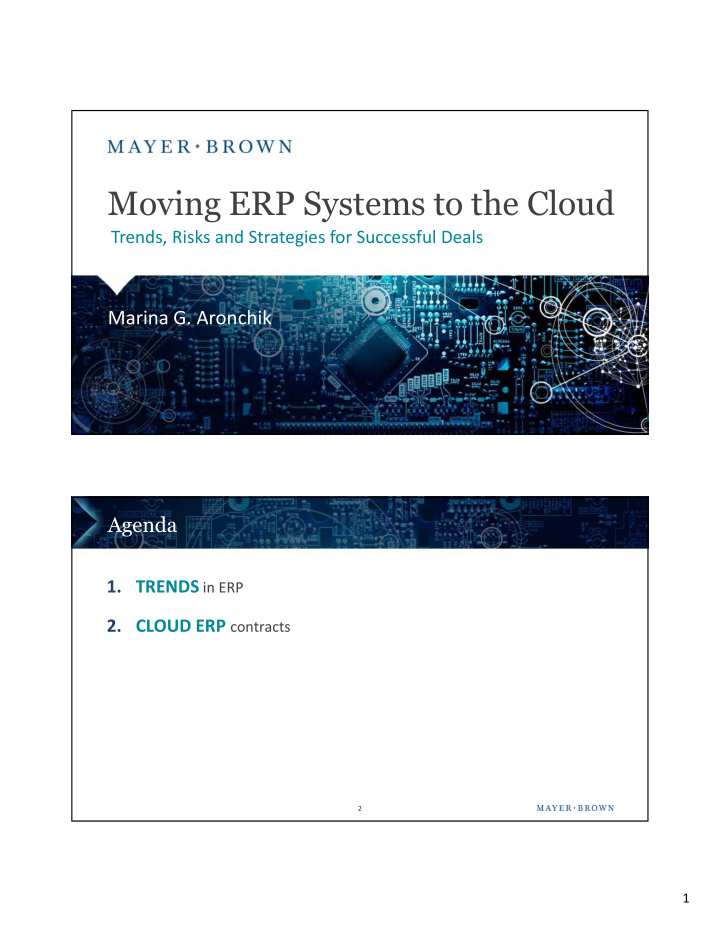



Moving ERP Systems to the Cloud Trends, Risks and Strategies for Successful Deals Marina G. Aronchik Agenda 1. TRENDS in ERP 2. CLOUD ERP contracts 2 1
Part I TRENDS IN ERP Key Terms • ERP (Enterprise Resource Planning) software is business process management software that allows an organization to use integrated applications to manage the business and automate functions • ON PREMISE – refers to a business hosting and running ERP software on its own infrastructure or infrastructure managed by a third-party provider for the business – examples include SAP, Oracle, JD Edwards • CLOUD ERP – ERP software made available on a “Software as a Service” basis, in which the ERP software provider hosts the software, manages the hosting environment and hosts most of the business’s data – examples include SAP, Oracle, Microsoft, and newer SaaS providers, like Salesforce, Workday, and many others • HYBRID ERP – a structure in which some ERP software modules are On Premise and others are hosted in the Cloud ERP 4 2
ERP: On-Premise versus Cloud TOPIC ON PREMISE CLOUD Implementation Lengthy Less lengthy Time High upfront costs; Lower upfront costs; less ongoing Costs investment in expert investment resources and infrastructure Beware of hidden costs Higher ability to manage Loss of some control over managing Compliance compliance risks compliance risks Customizations, Updates & Greater control and flexibility Less (or no) control and flexibility Performance 5 Expected Growth in Cloud ERP Adoption By 2019: 11% of organizations are pursuing a traditional On-Premise ERP strategy ( from 38% ) By 2020: 40% of large organizations will have at least 60% of their ERP applications in the cloud By 2025: 50% of large enterprises will implement a SaaS strategy to run their core ERP in the cloud 6 3
Part II CLOUD ERP CONTRACTS On-Premise and Cloud ERP Issues: Use & Users • Right to expand permitted users to broader company enterprise (third-party contractors, consultants, suppliers, customers) • Rights to use ERP system for acquired and divested businesses or companies • Consider indirect use • Clear definitions of users and other metrics (e.g., reassignment, expansion, exchange rights) 8 4
On-Premise and Cloud ERP Issues: Other Right to withhold disputed fees pending resolution Limitation of vendor’s right to terminate agreement or services Continuation of rights during contested terminations Protection against disruptions upon any termination or expiration of ERP use rights (e.g., ramp down rights) Indemnities Limitations of Liability 9 Cloud ERP Raises New Issues: Customer’s Flexibility • Customer’s right to regular and frequent extraction of ERP data for use in other customer systems • Customer’s right to continue to use services during the disengagement period • Customer’s right to renew services – Vendor’s right to not renew services (cloud terms tend to be shorter than on- premise license terms) 10 5
Cloud ERP Raises New Issues: Updates • Protections against vendor’s right to unilaterally change terms of service (“floating terms”) – Multiple layers of documentation make order of precedence very important • Protection against disruptive changes • Advance notification on changes to services 11 Cloud ERP Raises New Issues: Performance • Cloud agreement warranties tend to be weaker than those in on-premise software licenses • Cloud providers frequently subcontract obligations (and may disclaim liability for third-party cloud platform providers) 12 6
Cloud ERP Raises New Issues: Performance • Vendor service level commitments and penalties for failing to meet those commitments • Vendor right to suspend delivery of services • Contractual commitments of the provider regarding maintenance and support tend to be lighter for cloud, and support terms tend to be floating terms 13 Cloud ERP Raises New Issues: Data Protection & Compliance • Vendor commitments for security of company data and liability for data breaches – Customer’s reliance on vendor’s control audits and ISO certifications • Vendor obligations to protect confidentiality of company and personal data • Vendor data use for analytics or anonymously • Restrictions on vendor locations for data processing and storage of customer data • Vendor’s compliance with law obligations for the cloud services 14 7
Preparing for Cloud ERP Adoption Develop your own checklist of contractual requirements based on your company’s risk, compliance, privacy and security requirements Develop standard contractual clauses that address these requirements, and fallback positions Use the checklist to evaluate the cloud ERP terms and to educate your business about gaps or shortfalls in a provider’s ability to meet your requirements Determine an approach for mitigating risks around “floating terms” 15 Marina G. Aronchik QUESTIONS? Senior Associate +1 312 701 8168 maronchik@mayerbrown.com 16 8
Mayer Brown is a global legal services provider comprising legal practices that are separate entities (the "Mayer Brown Practices"). The Mayer Brown Practices are: Mayer Brown LLP and Mayer Brown Europe-Brussels LLP, both limited liability partnerships established in Illinois USA; Mayer Brown International LLP, a limited liability partnership incorporated in England and Wales (authorized and regulated by the Solicitors Regulation Authority and registered in England and Wales number OC 303359); Mayer Brown, a SELAS established in France; Mayer Brown JSM, a Hong Kong partnership and its associated legal practices in Asia; and Tauil & Chequer Advogados, a Brazilian law partnership with which Mayer Brown is associated. Mayer Brown Consulting (Singapore) Pte. Ltd and its subsidiary, which are affiliated with Mayer Brown, provide customs and trade advisory and consultancy services, not legal services. "Mayer Brown" and the Mayer Brown logo are the trademarks of the Mayer Brown Practices in their respective jurisdictions. 9
Recommend
More recommend